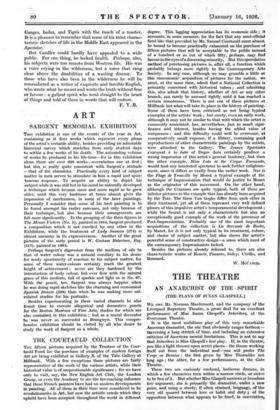THE COURTAULD COLLECTION
Tux fifteen pictures acquired by the Trustees of the Cour- tauld Fund for the purchase of examples of modern foreign Art are being exhibited in Gallery X of the Tate Gallery-at Milbank. With a few exceptions these pictures are fairly representative of the work of the various artists, while their historical value is of unquestionable significance ; for we have only to visit, say, the New English Art Club, the London Group, or even the Academy to see the far-reaching influence that these French painters have had on modern developments in painting. All of them in their time were considered to be revolutionaries in Art, but now the artistic creeds which they upheld have been accepted throughout the world in different degree. This lagging appreciation has its economic side ; ii accounts, in some measure, for the fact that any semi-official fund like that provided by, Mr. Samuel Courtauld must almost be bound to become practically exhausted on the purchase of fifteen pictures that will be acceptable to ;the public instead of a hundred or so out of which fifty, perhaps, may find favour in the eyes of a discerning minority. But this speculative method of purchasing pictures is, after all, a function_ which probably belongs more rightly to the Contemporary -Arts Society. In any ense, although we may grumble a little at this uneconomic acquisition of .pictures for the nation, we Must, at the same time, admit that a National Collection is primarily concerned with historical values ; and admitting this, also admit that history, whether of Art or any other branch, can rarely be assessed rightly until it has reached a certain remoteness. There is not one of these pictures at Millbank but what will take its place in the history of painting. Some of them have been criticized as not being typical examples of the artists' work ; but surely, even an early work, although it may not be similar to that with which the artist is .commonly associated, has, nevertheless, just as much signi- ficance and interest, besides having the added value of uniqueness : and this difficulty could well be overcome, at comparatively small expense, if a library, containing good reproductions of other characteristic paintings by the artists, were attached to the Gallery. The Jeunes Spartiates s'exerrant a la tulle of Degas does certainly produce a wrong impression of this artist's general tendency, but then the other example, Miss Lola at the Cirque Farnando; would lead any interested spectator to seek further enlighten- ment, since it differs so vastly from the earlier work. Nor is the Plage de Trouville by Monet a typical example of the technique of Impressionism that would do justice to -Monet as the :originator of this movement. On the other hand; although the Cezannes are quite typical, bOth of them are inferior pictures to the example that has already been acquired by the Tate. The three. Van Goghs differ from each other in their treatment, yet all- of them represent very well defined phases of this impulsive artist's temperamental development ; while the Seurat is not only a characteristic but also an exceptionally good example of the work of the precursor of Post:Impressionism. Probably one of the most important acquisitions of the collection is La Servante de Backs, by Manet, for it is not only typical in its treatment, colour; and choice of subject matter, but also shows the artist's powerful sense of constructive design—a sense which most of
the contemporary Impressionists lacked. „
Besides the pictures already referred to, there are also characteristic, works of Renoir, Pissarro, Sisley, Utrillo, and Bonnard.
W. McCamea.














































 Previous page
Previous page